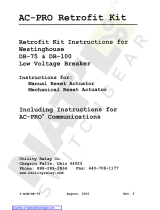GE AK-50
GE AK-50 is a low-voltage power circuit breaker designed for upgrading existing GE low-voltage power circuit breakers. It includes ProTrip™ Trip Units, the latest technological advance in GE trip systems. ProTrip Conversion Kits are designed and tested to conform to ANSI Standard C37.59, allowing the retrofitter to properly install the kit and acceptance test the breaker.
Capabilities:
- Converts existing GE EC trip systems to ProTrip™ Trip Units
- Provides enhanced protection and reliability
- Conforms to ANSI Standard C37.59
- Can be used for a wide range of applications, including commercial, industrial, and residential settings
GE AK-50
GE AK-50 is a low-voltage power circuit breaker designed for upgrading existing GE low-voltage power circuit breakers. It includes ProTrip™ Trip Units, the latest technological advance in GE trip systems. ProTrip Conversion Kits are designed and tested to conform to ANSI Standard C37.59, allowing the retrofitter to properly install the kit and acceptance test the breaker.
Capabilities:
- Converts existing GE EC trip systems to ProTrip™ Trip Units
- Provides enhanced protection and reliability
- Conforms to ANSI Standard C37.59
- Can be used for a wide range of applications, including commercial, industrial, and residential settings




















-
 1
1
-
 2
2
-
 3
3
-
 4
4
-
 5
5
-
 6
6
-
 7
7
-
 8
8
-
 9
9
-
 10
10
-
 11
11
-
 12
12
-
 13
13
-
 14
14
-
 15
15
-
 16
16
-
 17
17
-
 18
18
-
 19
19
-
 20
20
-
 21
21
-
 22
22
-
 23
23
-
 24
24
-
 25
25
-
 26
26
-
 27
27
-
 28
28
-
 29
29
-
 30
30
-
 31
31
-
 32
32
GE AK-50
GE AK-50 is a low-voltage power circuit breaker designed for upgrading existing GE low-voltage power circuit breakers. It includes ProTrip™ Trip Units, the latest technological advance in GE trip systems. ProTrip Conversion Kits are designed and tested to conform to ANSI Standard C37.59, allowing the retrofitter to properly install the kit and acceptance test the breaker.
Capabilities:
- Converts existing GE EC trip systems to ProTrip™ Trip Units
- Provides enhanced protection and reliability
- Conforms to ANSI Standard C37.59
- Can be used for a wide range of applications, including commercial, industrial, and residential settings
Ask a question and I''ll find the answer in the document
Finding information in a document is now easier with AI
Other documents
-
 Woodford 19CP-6 Specification
Woodford 19CP-6 Specification
-
Kollmorgen AKD-N00307 Installation guide
-
 NATIONAL SWITCHGEAR Westinghouse DB-100 User manual
NATIONAL SWITCHGEAR Westinghouse DB-100 User manual
-
Kollmorgen AKD PDMM Installation guide
-
Kollmorgen AKD series Installation guide
-
ABB COV-7 Instruction Leaflet
-
Kollmorgen AKD series Installation guide
-
Kollmorgen AKD-N series Installation guide
-
ABB CVE-3 Instruction Leaflet
-
ABB KD-10 Instruction Leaflet

































